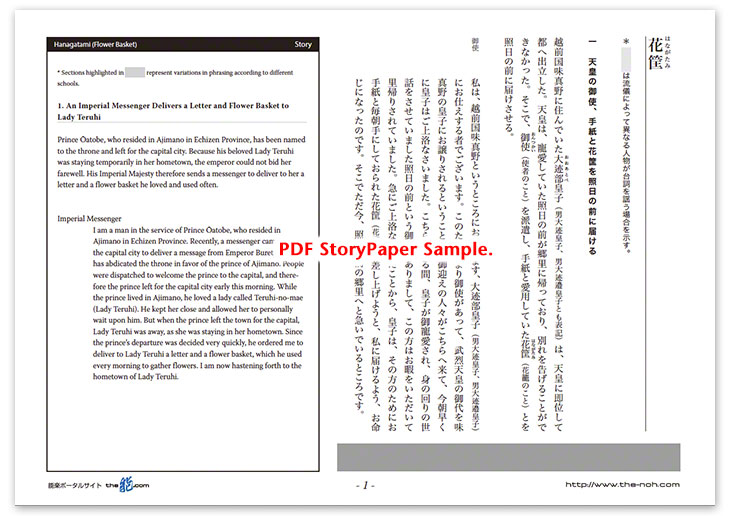
 Hanagatami (Flower Basket)
Hanagatami (Flower Basket)

![]()
Prince Ōatobe, a descendant of Emperor Ōjin, lived in Ajimano in Echizen Province (the present-day Ajimano district in Echizen City, Fukui Prefecture). Since Emperor Buretsu abdicated the throne, Prince Ōatobe became Emperor Keitei* (450? – 531?) and departed for the capital city. The new emperor asks a messenger to deliver a letter to Teruhi-no-mae (Lady Teruhi), whom he loved in Ajimano, along with a flower basket that he loved and used often. Away from her home, Lady Teruhi meets the messenger. Although she is delighted that Keitei ascended to the throne, she cannot stop feeling lonely and sad about their being apart. She holds the letter and flower basket closely to her bosom and returns to her home.
Emperor Keitei moves the capital city to Tamaho in Yamato Province (the present-day Ikenouchi district in Sakurai City, Nara Prefecture) and goes out to enjoy viewing the crimson leaves with his guards on an autumn day. Then, Lady Teruhi appears there with her servant, holding the flower basket. Her strong love for the emperor has driven her crazy, and she left her hometown to travel to the capital city to meet with him. When the deranged Lady Teruhi rushes out in front of the emperor’s procession, she is stopped by his guards, who hit the flower basket in her servant’s hand. The flower basket falls to the ground. Lady Teruhi reproachfully demands to know who is this insane man whose actions have caused the emperor’s favorite flower basket to fall to the ground. She then collapses onto the ground and cries sadly because she cannot see the emperor.
On the emperor’s orders, the guard tells Lady Teruhi to perform a mad dance in front of the procession. After performing a dance of pleasure, she narrates the tragic love story of Emperor Wu of the Han Dynasty and his concubine Lady Li, comparing it to her situation as an expression of her love for the emperor.
The emperor, who receives the flower basket from Lady Teruhi, confirms that this is the basket he used to use. He tells her that the two of them will be together again if she comes to her senses. Appreciating his deep love and compassion, Lady Teruhi regains her right mind. According to a legend, this story of the flower basket (“katami”) led to the word “katami” taking on the meaning of a memento that a beloved one loved and used. The emperor and Lady Teruhi go back to the capital city together.
*More commonly known as Emperor Keitai, but called Keitei in Noh dramas.
![]()
This Noh drama takes its inspiration from an ancient legend that it rearranged as a love story. It follows the typical plot elements of a Kyōjo-mono (“story of a mad woman”): “separation, madness, travel, dance of madness, lovers’ reunion, and happy ending.” But because of its gentle, graceful atmosphere, it is also performed as a third group Noh play. It depicts the elegant sentiments of a woman devoted to her love for the emperor.
Highlights are as follows. The figure of Lady Teruhi calmly reading the letter from the emperor. The interactive chants between Lady Teruhi and her servant as they head to the capital city. The kakeri dance expressing her being driven insane by love. The mad dance expressing the lament of Lady Teruhi after her encounter with the emperor’s entourage, who hit her attendant, knocking the flower basket to the ground. Lady Teruhi’s kuse dance expressing the tragic love story of Emperor Wu of the Han Dynasty and Lady Li, accompanied by tsuyogin (“a strong song”). And the behavior of Lady Teruhi when filled with joy upon being reunited with the emperor. Each part contains well-designed presentations of unique singing, movements, and dance. The overall effect achieves a delicate depiction of the poetic, bright, and gentle atmosphere of ancient Japan. Each scene of this drama is thoroughly enjoyable.
STORY PAPER : Hanagatami (Flower Basket)
Story Paper presents noh chant stories in modern speech, with story outlines, highlights and more using Adobe PDF format, which can print out and zoom in. Print out the pages and take them with you when you see the actual noh performance.

The copyright of Story Paper is held by the Noh.com. Story Paper is for individual use only. It is prohibited by the copyright law to distribute or publish printed-out Story Paper pages without prior consent. For more information, check the credit and disclaimer pages.



 [Hanagatami (Flower Basket) : Story Paper PDF : 556KB
[Hanagatami (Flower Basket) : Story Paper PDF : 556KB